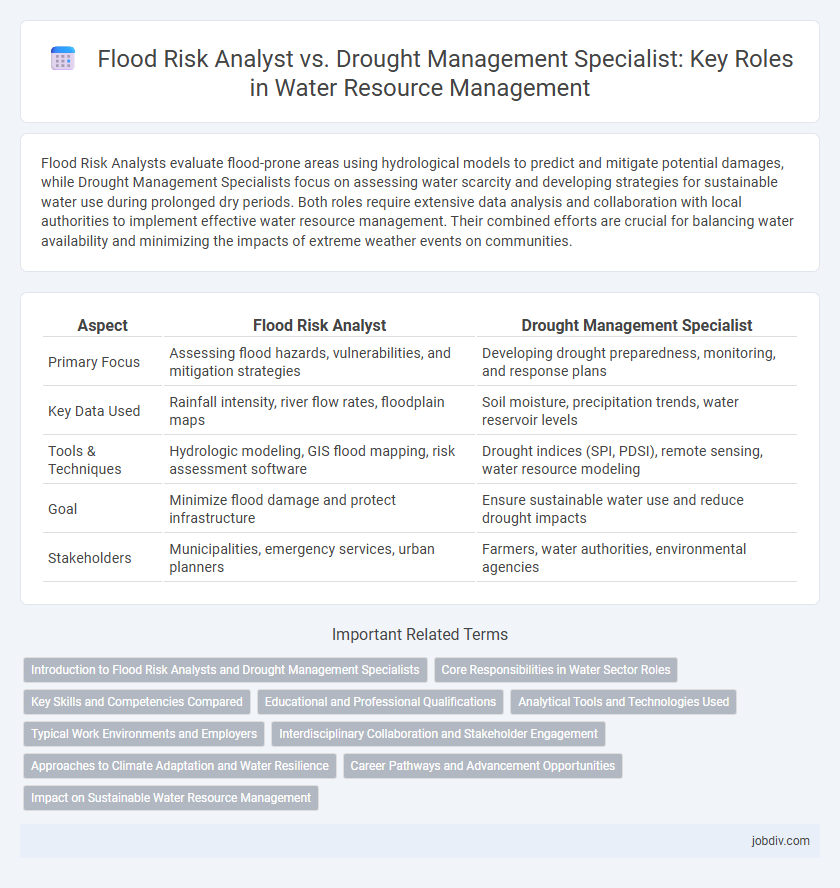Flood Risk Analysts evaluate flood-prone areas using hydrological models to predict and mitigate potential damages, while Drought Management Specialists focus on assessing water scarcity and developing strategies for sustainable water use during prolonged dry periods. Both roles require extensive data analysis and collaboration with local authorities to implement effective water resource management. Their combined efforts are crucial for balancing water availability and minimizing the impacts of extreme weather events on communities.
Table of Comparison
| Aspect | Flood Risk Analyst | Drought Management Specialist |
|---|---|---|
| Primary Focus | Assessing flood hazards, vulnerabilities, and mitigation strategies | Developing drought preparedness, monitoring, and response plans |
| Key Data Used | Rainfall intensity, river flow rates, floodplain maps | Soil moisture, precipitation trends, water reservoir levels |
| Tools & Techniques | Hydrologic modeling, GIS flood mapping, risk assessment software | Drought indices (SPI, PDSI), remote sensing, water resource modeling |
| Goal | Minimize flood damage and protect infrastructure | Ensure sustainable water use and reduce drought impacts |
| Stakeholders | Municipalities, emergency services, urban planners | Farmers, water authorities, environmental agencies |
Introduction to Flood Risk Analysts and Drought Management Specialists
Flood Risk Analysts evaluate hydrological data and identify areas prone to flooding, utilizing geographic information systems (GIS) and climate models to predict flood events and develop mitigation strategies. Drought Management Specialists focus on assessing water scarcity and its impact on agriculture, ecosystems, and communities, employing drought indices and water resource management tools to devise adaptive measures. Both roles require expertise in environmental science, data analysis, and risk assessment to enhance water resource resilience under changing climatic conditions.
Core Responsibilities in Water Sector Roles
A Flood Risk Analyst primarily focuses on assessing flood hazards, analyzing hydrological data, and developing mitigation strategies to minimize flood impacts on communities and infrastructure. In contrast, a Drought Management Specialist monitors water scarcity indicators, implements water conservation plans, and designs adaptive strategies to sustain water resources during prolonged dry periods. Both roles require expertise in environmental data analysis, but their core responsibilities address distinct challenges within the water sector.
Key Skills and Competencies Compared
Flood Risk Analysts excel in hydrological modeling, GIS mapping, and floodplain management, enabling precise flood risk assessment and mitigation planning. Drought Management Specialists possess expertise in soil moisture monitoring, water resource allocation, and climate impact analysis to optimize drought preparedness and response strategies. Both roles require strong data analysis, environmental science knowledge, and proficiency in remote sensing technologies for effective water management.
Educational and Professional Qualifications
Flood Risk Analysts typically require a background in hydrology, environmental science, or civil engineering, often holding a bachelor's or master's degree in these fields, supplemented by certifications in GIS and risk assessment. Drought Management Specialists commonly possess degrees in climatology, meteorology, or agricultural science, with advanced knowledge in water resource management and experience in drought impact modeling. Both roles demand strong analytical skills and proficiency in environmental data analysis tools, although their specialized training reflects the distinct challenges of flood and drought risk mitigation.
Analytical Tools and Technologies Used
Flood Risk Analysts utilize hydrological modeling software such as HEC-RAS and GIS-based tools to simulate flood scenarios and assess floodplain extents. Drought Management Specialists rely on remote sensing technologies, soil moisture sensors, and climate data analytics platforms like the Drought Monitor to monitor drought conditions and predict water shortages. Both professionals employ statistical analysis and data visualization software to interpret complex environmental data for informed decision-making.
Typical Work Environments and Employers
Flood Risk Analysts typically work for government agencies, environmental consulting firms, and insurance companies, focusing on urban planning and flood defense projects. Drought Management Specialists are often employed by agricultural organizations, water resource management agencies, and climate research institutions to develop conservation strategies and monitor water scarcity. Both roles operate in field settings, using geographic information systems (GIS) and hydrological models to assess and manage water-related risks.
Interdisciplinary Collaboration and Stakeholder Engagement
Flood Risk Analysts and Drought Management Specialists collaborate closely with hydrologists, meteorologists, urban planners, and emergency responders to develop comprehensive water risk mitigation strategies. Effective stakeholder engagement involves government agencies, community groups, and environmental organizations to ensure resilient policies that address both flood hazards and prolonged water scarcity. Integrating multidisciplinary data and fostering transparent communication channels enable proactive decision-making in managing diverse water-related challenges.
Approaches to Climate Adaptation and Water Resilience
Flood Risk Analysts utilize hydrological modeling, floodplain mapping, and early warning systems to predict and mitigate flood impacts, enhancing urban and rural water infrastructure resilience. Drought Management Specialists implement water conservation strategies, drought contingency planning, and demand management to sustain water supply and ecosystem health during prolonged dry periods. Both roles integrate climate adaptation frameworks that emphasize adaptive management, stakeholder collaboration, and data-driven decision-making to strengthen overall water resilience against climate variability.
Career Pathways and Advancement Opportunities
Flood Risk Analysts specialize in assessing and mitigating flood hazards through data modeling and hydrological analysis, often progressing to senior roles in environmental consulting or government agencies. Drought Management Specialists focus on water scarcity solutions, developing strategies for resource allocation and sustainability, with advancement opportunities in policy development and climate resilience organizations. Both career paths offer growth in interdisciplinary fields, emphasizing expertise in climate science, data analytics, and regulatory frameworks for water resource management.
Impact on Sustainable Water Resource Management
Flood Risk Analysts evaluate hydrological data to predict and mitigate flood hazards, protecting infrastructure and ecosystems from water-related damage. Drought Management Specialists develop strategies to optimize water use during prolonged dry periods, ensuring water availability and resilience for agricultural and urban needs. Their combined expertise supports sustainable water resource management by balancing flood prevention with effective drought response, preserving water security amidst climate variability.
Flood Risk Analyst vs Drought Management Specialist Infographic

 jobdiv.com
jobdiv.com